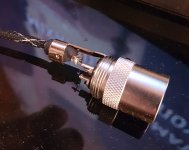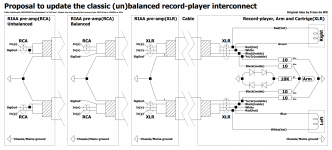Due to a change of a phono stage, I may need to replace the balanced (XLR) connectors of my tonearm with unbalanced connectors (single ended RCA).
So far I didn't have any ground wire, the XLRs connect directly to balanced inputs on my preamp.
If I use RCAs, do I need a ground wire? And if yes, where do I get it? If I take the shielding from the XLR side of the cable , solder it to a thin cable connecting to my preamp, would that be a reasonable way to come up with ground cable?
So far I didn't have any ground wire, the XLRs connect directly to balanced inputs on my preamp.
If I use RCAs, do I need a ground wire? And if yes, where do I get it? If I take the shielding from the XLR side of the cable , solder it to a thin cable connecting to my preamp, would that be a reasonable way to come up with ground cable?
A grounding cable will normally be connected to your tonearm tube & your metal chassis parts, which is kept separate from the screens of the cartridge down to your pre amp to keep the noise down.
There is no grounding cable because the tonearm wiring was custom made for me by the manufacturer.
I can see in this photo that two super thin wires connect the two cartridge pins to the two XLR connector pins, and the cable shielding connects to the third XLR pin.
Is this a proper grounding cable, meaning if I extend it with a longer cable and lug it will play the part of a common GND tonearm cable?
Attachments
RCA doesn't automatically means Single Ended !Due to a change of a phono stage, I may need to replace the balanced (XLR) connectors of my tonearm with unbalanced connectors (single ended RCA).
When using the connection below, the left part of your cable can stay what it is now and on the right side input 1&2 are terminated with an RCA plug, while the cable shield is separately connected to the chassis of your Phono Stage.
Succes,
Hans
Attachments
As far as I know using this 2 core screened cable is not the correct way to wire from a record player & I have tried many different ways that do not work for me but at the end of the day people change things like they are trying to re-invent the wheel.
The only other mod I have seen on a record player is to earth you chassis & tone arm ground to your right screened cable on the pcb before it is changed to the screened cable (output from record player) to the pre-amp, but this is done in DJ turntables as the ground cable gets stretched & broke.
You are supposed to use the negative pin from the cartridge as a screen not use chassis ground as the screen.
The only other mod I have seen on a record player is to earth you chassis & tone arm ground to your right screened cable on the pcb before it is changed to the screened cable (output from record player) to the pre-amp, but this is done in DJ turntables as the ground cable gets stretched & broke.
You are supposed to use the negative pin from the cartridge as a screen not use chassis ground as the screen.
Well, I managed to get a reply by the tonearm manufacturer.
I am supposed to use the cable shield as the ground. So , I will remove each Oyaide XLR from its cable, use the two thin shielded wires for each RCA and solder the jacket shield to a cable with a small spade connector on its end , running to my phono preamp.
I will do the same thing to the other channel and connect its shield to the same ground wire.
Thank you all for your suggestions!
I am supposed to use the cable shield as the ground. So , I will remove each Oyaide XLR from its cable, use the two thin shielded wires for each RCA and solder the jacket shield to a cable with a small spade connector on its end , running to my phono preamp.
I will do the same thing to the other channel and connect its shield to the same ground wire.
Thank you all for your suggestions!
As some know (Calvin  ) I am always capable of changing a simple subject into a complicated (seemingly IMHO) solution. Here I donate my latest's record-tonearm-and-plyer cabling solution to the public domain, have fun with it, and lets here about it
) I am always capable of changing a simple subject into a complicated (seemingly IMHO) solution. Here I donate my latest's record-tonearm-and-plyer cabling solution to the public domain, have fun with it, and lets here about it 
Drawings are: 1> Schema, 2> Implementation (sort of), 3> outer (chassis) ground high lighted (green) and 4> inner (audio) ground high light (red).
P.S. R2 and the diodes are 'not there', the impedance of these is so high (compared to the other ground connections) that there is no way for them to carry any (practical or un-practical) current. The purpose of R2 and the diodes is to prevent any static buildup in the tone arm (or dielectric dielectric charging of any of the materials in use) when the system is disconnected.
P.P.S. I agree with Calvin who agrees with dd on agreeing with Hans
Frans.
Drawings are: 1> Schema, 2> Implementation (sort of), 3> outer (chassis) ground high lighted (green) and 4> inner (audio) ground high light (red).
P.S. R2 and the diodes are 'not there', the impedance of these is so high (compared to the other ground connections) that there is no way for them to carry any (practical or un-practical) current. The purpose of R2 and the diodes is to prevent any static buildup in the tone arm (or dielectric dielectric charging of any of the materials in use) when the system is disconnected.
P.P.S. I agree with Calvin who agrees with dd on agreeing with Hans
Frans.
Attachments
-
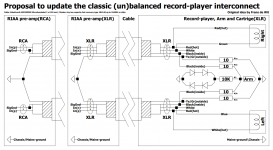 Draft23; Zion; Cable system; Cable diagram.png204.7 KB · Views: 582
Draft23; Zion; Cable system; Cable diagram.png204.7 KB · Views: 582 -
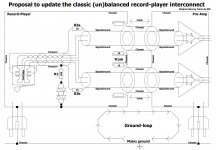 Draft23; Zion; Cable system; Mech view all.png175.7 KB · Views: 584
Draft23; Zion; Cable system; Mech view all.png175.7 KB · Views: 584 -
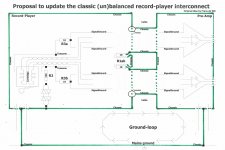 Draft23; Zion; Cable system; Mech view outer ground.jpg620.6 KB · Views: 706
Draft23; Zion; Cable system; Mech view outer ground.jpg620.6 KB · Views: 706 -
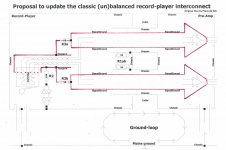 Draft23; Zion; Cable system; Mech view inner(signal) ground.jpg379.5 KB · Views: 391
Draft23; Zion; Cable system; Mech view inner(signal) ground.jpg379.5 KB · Views: 391
Last edited:
To my taste overly complicated.And (for completeness) the schema updated with balanced-RCA.
1) Better not to separately connect the TT chassis to the mains ground, since the preamp is already connected to mains ground transfering this connection to the TT Chassis.
A double connection may potentially create an unwanted ground loop and is not solving any other problem.
2) Connecting the arm to the signal gnd can be done, but only when it does not have a connection to the chassis and only when a signal gnd is available from the preamp.
But I see no advantage over having the arm connected to the TT chassis.
3) to connect the signal gnd to the mains gnd in the TT is another loop being created, because the signal gnd is already connected to the mains gnd somewhere in the Pre Amp.
4) in case of a balanced RCA Pre Amp, there is likely no signal gnd available, causing the the arm to float with this setup, just another reason to connect the arm to the TT Chassis.
So my advice would be to connect the arm to the TT chassis if not already done by the manufacturer, and let the Mains Gnd come from the Preamp chassis.
Hans
To my taste overly complicated
Its not that complicated, only a few resistors and diodes. What you get in return is a universal connection system that supports balanced and un-balanced while providing a good shield against HF pollutions (like phone and wifi signals). Also the schema will function with mains-grounded record-players and non mains grounded record players. It can satisfy doubly isolated and single isolated standards in one cabling system.
1) Better not to separately connect the TT chassis to the mains ground, since the preamp is already connected to mains ground transfering this connection to the TT Chassis. A double connection may potentially create an unwanted ground loop and is not solving any other problem.
Witch is not done, the ground-loop is broken by the 10 Ohm resistors. But the connection to mains ground is unbroken.
2) Connecting the arm to the signal gnd can be done, but only when it does not have a connection to the chassis and only when a signal gnd is available from the preamp. But I see no advantage over having the arm connected to the TT chassis.
The arm is not connected to ground, only if a static charge (om the arm) is larger than 2 x Vka(diode), this is (must be seen as) normally not-connected.
3) to connect the signal gnd to the mains gnd in the TT is another loop being created, because the signal gnd is already connected to the mains gnd somewhere in the Pre Amp.
This is not done, the arm is not connected to ground (it es actually part of the shielding system).
4) in case of a balanced RCA Pre Amp, there is likely no signal gnd available, causing the the arm to float with this setup, just another reason to connect the arm to the TT Chassis. So my advice would be to connect the arm to the TT chassis if not already done by the manufacturer, and let the Mains Gnd come from the Preamp chassis.
No floating of the arm (except when the balanced RIAA input is a transformer with no center tap), otherwise the input network should/will provide some path to signal ground.
Last edited:
... and let the Mains Gnd come from the Preamp chassis.
How would you do that while guarantying (mains wiring) standards?
- Status
- This old topic is closed. If you want to reopen this topic, contact a moderator using the "Report Post" button.
- Home
- Source & Line
- Analogue Source
- Grounding on tonearm
